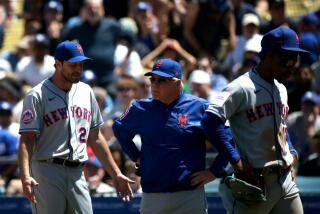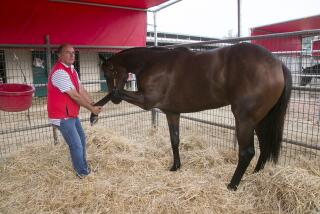Rusedski Becomes Center of Attention
Coincidentally or not, several pages of anti-doping program data from 2003 materialized -- listed as New! -- on the website of the ATP, which runs menâs tennis, detailing in-competition testing, out-of-competition testing and testing of blood samples for EPO.
If you want to see how many times U.S. Open champion Andy Roddick or Wimbledon winner Roger Federer or Andre Agassi had to submit to a drug test last year, itâs all there.
Roddick was tested 16 times in competition (twice in Washington), Agassi 12 times in competition (twice in Washington) and Federer 20 times in competition, including three times in the first round of the Davis Cup at Arnhem, Netherlands. And Greg Rusedski was tested three times during the summer hard-court season, at events in Indianapolis, Washington and Montreal.
An ATP spokesperson said that overall there were 36% more tests in 2003 compared with 2002, and that more than 70 tests were conducted out of competition, 20 of them by the World Anti-Doping Agency (WADA).
On the ATPâs website, 38 players accounted for 46 out-of-competition tests. Agassi was tested three times, and Rusedski and Tim Henman were tested once, on the same day, Dec. 10, according to the material. (This caveat was listed at the end of the document: While the ATP ... and ITF have used reasonable efforts to include accurate information in this release, these organizations, individually and collectively, make no warranties or representations to its accuracy.)
This was all being digested on Monday, the same day the 100th-ranked tennis player in the world appeared at a hearing before a three-member tribunal at a Montreal law firm, a panel investigating his positive drug test for a banned substance, the steroid nandrolone.
Such an event, under ordinary circumstances, would merit perhaps a line or two at the end of a news summary. And probably not even that. Because of confidentiality issues, these types of cases would not become public unless there were a guilty verdict and suspension.
But Greg Rusedski is no ordinary 100th-ranked player.
He represents Great Britain and is followed around the world by a sizable, dedicated and investigative press corps. When rumors of a positive drug test surfaced, first thought to be THG, which was incorrect, he went on the offensive last month in Australia in unprecedented fashion, revealing the positive test for nandrolone. Rusedski tested positive at the Indianapolis tournament last summer.
According to reports, he arrived and left the hearing in Montreal on Monday without making a comment. There were about eight hours between his arrival at the law firm and departure.
The independent tribunal, appointed by the ATP, was led by former United Nations ambassador and lawyer Yves Fortier. The names of the two other panel members have not yet been released.
Rusedski, a finalist at the U.S. Open in 1997, has contended that his sample has the same âanalytical fingerprintâ as those of seven other players who had positive tests for nandrolone. Of those seven, six remain secret. The seventh, Bohdan Ulihrach of the Czech Republic, was suspended last year and appealed to the Court of Arbitration for Sport (CAS) in Lausanne, Switzerland.
Before the matter reached the CAS, the ATP reconvened and lifted his suspension, saying it could not be certain that its own trainers did not inadvertently give the players contaminated products. That announcement came in the form of a report by anti-doping expert Richard Young, which was days after Wimbledon ended in July, and appeared to tie it up neatly and conveniently.
Not quite.
Even before the Rusedski case, there were more questions than answers about the Secret Six.
âMr. Youngâs report ended up pointing the finger at electrolytes given to players by trainers on the ATP Tour,â Rusedski said in a statement last month. âHowever, this was mere speculation. Mr. Youngâs team analyzed the electrolytes that were given and found they all tested negative. The simple fact of the matter is that Mr. Young could not identify why all these samples demonstrated elevated results.â
One interested party is WADA, which is examining the ATPâs investigation of the other seven players -- which should come out within a few weeks -- but does not hold any jurisdiction because menâs tennis has not yet adopted WADAâs code.
WADAâs director-general, David Howman, was not sold on the theory in the Young Report.
âIt hasnât been tested. Thatâs the very nub of our concern,â he told the British paper, the Sunday Telegraph. âUlihrach was going to go to [CAS], this theory came along and, instead of going to court and having it heard, they [the ATP] pulled that case back into their own domestic tribunal and said, âWeâll have a rehearing of this, thanks very much, hereâs this theory.â There was no opposition to it, there was no testing of it.â
More to Read
Go beyond the scoreboard
Get the latest on L.A.'s teams in the daily Sports Report newsletter.
You may occasionally receive promotional content from the Los Angeles Times.











